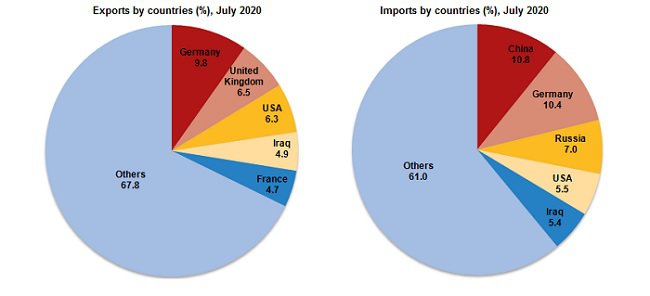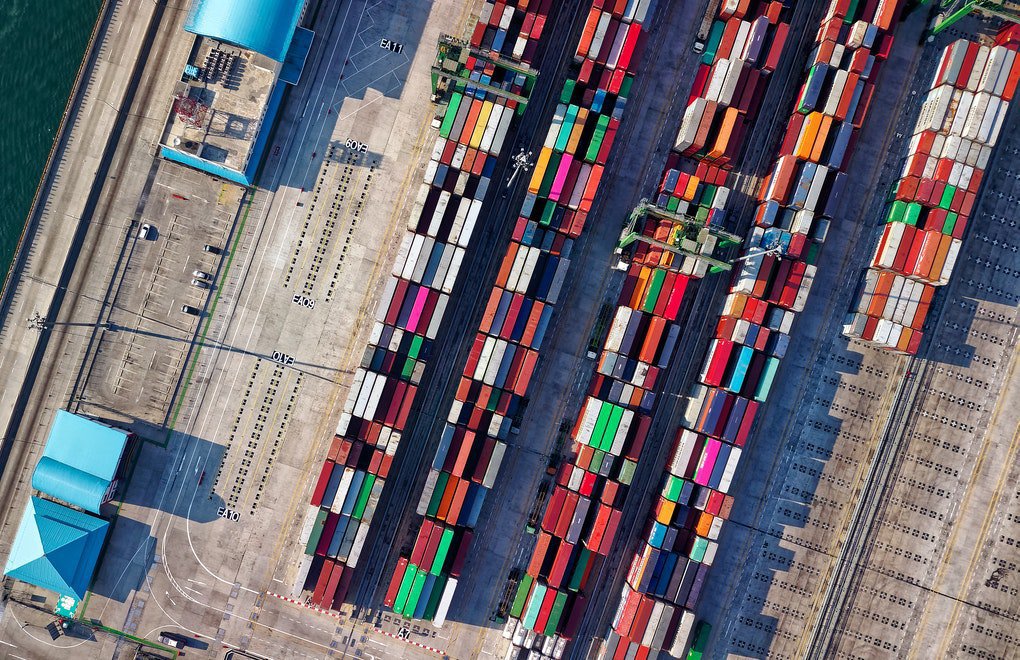Fotoğraf: Tom Fisk / Pexels
Click to read the article in Turkish
Turkey's exports this July dropped by 5.8 percent to 15 billion dollars, while imports fell 7.9 percent to 17.7 billion dollars on an annual basis, according to the data prepared by the Turkish Statistical Institute (TurkStat) and the Ministry of Trade.
The country's trade balance posted a 2.7 billion dollar deficit in July, according to the institute's figures.
The export-to-import coverage ratio was 84.8 percent in July 2020 versus 82.9 percent in July 2019.
In the January-July period, the country's exports were 90 billion dollars, dropping 13.7 percent year-on-year, while imports were 116.6 billion dollars, down 3.9 percent.
The trade deficit was 26.6 billion dollars in the first seven months -- the export-to-import coverage ratio was 77.2 percent.
Here are highlights from the report:
Exports, excluding energy products and non-monetary gold, were 14 billion 562 million dollars with a 2.7 percent decrease in July 2020. Imports, excluding energy products and non-monetary gold, were 13 billion 348 million dollars with a 10.5 percent decrease.
The foreign trade surplus, excluding energy products and non-monetary gold, was 1 billion 214 million dollars in July 2020.
Foreign trade volume was 29 billion 882 million dollars with a decrease of 6.6 percent. Energy products and non-monetary gold excluded export coverage in imports was 109.1 percent.

In July 2020 foreign trade deficit was 2 billion 697 million dollars with an 18.2 percent decrease compared with July 2019. In July 2020, export coverage imports were 84.8 percent while it was 82.9 percent in July 2019.
In the January-July period, the foreign trade deficit was 26 billion 590 million dollars with a 55.6 percent increase compared with January-July 2019. In the same period, exports coverage imports were 77.2 percent while it was 85.9 percent in January-July 2019.
In July 2020, according to economic activities, the ratios of manufacturing industries products, agriculture, forestry and fishing, mining and quarrying in total exports were 95.1 percent, 2.8 percent, 1.6 percent, respectively.
In the January-July period, according to economic activities, the ratios of manufacturing industries products, agriculture, forestry and fishing, mining and quarrying in total exports were 94.4 percent, 3.5 percent, 1.7 percent, respectively.
In July 2020, according to the BEC classification, the ratios of intermediate goods, capital goods and consumption goods in total imports were 72.3 percent, 15.3 percent, 12.2 percent, respectively.
In the January-July period, according to the BEC classification, the ratios of intermediate goods, capital goods and consumption goods in total imports were 75.2 percent, 13.9 percent, 10.6 percent, respectively.
The top partner for exports was Germany
In July 2020, the main partner country for exports was Germany with 1 billion 468 million dollars. The country was followed by the United Kingdom with 973 million dollars, the US with 952 million dollars, Iraq with 743 million dollars, and France with 704 million dollars. The ratio of the first five countries in total exports was 32.2 percent in July 2020.
In the January-July period, the main partner country for exports was Germany with 8 billion 567 million dollars. The country was followed by the US with 5 billion 570 million dollars, the United Kingdom with 5 billion 428 million dollars, Iraq with 4 billion 816 million dollars, Italy with 4 billion 233 million dollars. The ratio of the first five countries in total exports was 31.8 percent in January-July 2020.
Most imports were from China
In July 2020, the top country for Turkey's imports was China with 1 billion 912 million dollars. The country was followed by Germany with 1 billion 835 million dollars, Russia with 1 billion 233 million dollars, the US with 970 million dollars, Iraq with 962 million dollars. The ratio of the first five countries in total imports was 39.0 percent in July 2020.
In the January-July period, the top country for Turkey's imports was China with 12 billion 288 million dollars. The country was followed by Germany with 10 billion 948 million dollars, Russia with 9 billion 964 million dollars, the US with 7 billion 32 million dollars and Italy with 4 billion 654 million dollars. The ratio of the first five countries in total imports was 38.5 percent in January-July 2020.
Foreign trade by technology intensity covers the manufacturing industries' products in the classification of ISIC Rev.4. According to the ISIC Rev.4, the ratio of manufacturing industries products in total exports was 95.1 percent in July 2020. The ratio of high-technology products in manufacturing industries exports was 2.9 percent. In the January-July 2020 period, the ratio of high-technology products in manufacturing industries exports was 3.4 percent.
The ratio of manufacturing industries' products in total imports was 82.3 percent. The ratio of high-technology products in manufacturing industries' imports was 12.3 percent in July 2020. The ratio of manufacturing industries' products in total imports was 80.4 percent in January-July 2020. The ratio of high-technology products in manufacturing industries' imports was 13.2 percent in January-July 2020. (HA/VK)







